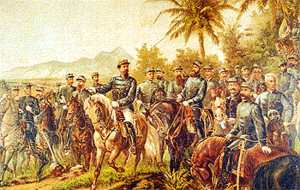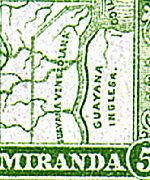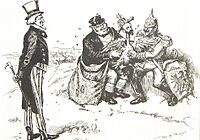History of Venezuela (1830–1908) facts for kids
After the Venezuelan War of Independence, Venezuela became free from the Spanish Empire. At first, it was part of a bigger country called Gran Colombia. But there were disagreements inside, and Gran Colombia broke apart in 1830. Venezuela then declared its own independence. For the rest of the 1800s, Venezuela was led by many caudillos, who were strong military leaders. Important figures included José Antonio Páez (1829–1847), Antonio Guzmán Blanco (1870–1887), and Cipriano Castro (1899–1908).
One very tough conflict was the Federal War (1858–1863). This war led to the creation of the modern States of Venezuela, replacing the older provinces from colonial times. Towards the end of the century, Venezuela faced some big international problems. These events helped shape the United States' Monroe Doctrine, which was about keeping European powers out of the Americas. Two main crises were the Venezuela Crisis of 1895 (a land dispute with Britain) and the Venezuela Crisis of 1902–1903 (when Venezuela refused to pay its debts to other countries).
Contents
Venezuela's Early Challenges
Venezuela's geography made it hard to govern. It has many different regions, like the Andes mountains, the wide plains called the llanos, the Maracaibo basin, and central areas around Caracas. Most of these regions were separated by mountains. The llanos, however, were open plains. These different regions often had their own ways and leaders.
After gaining independence, Venezuela was one of the poorest countries in Spanish America. Many people had died during the long wars. In 1800, about one million people lived there, but after the wars, the population likely dropped. The country had very few good roads, mostly just old "royal roads" from colonial times. Travel was difficult, often just on mule tracks.
Caracas, the capital, was rebuilding but had lost its former glory. It didn't have impressive public buildings. Most of Venezuela was rural, meaning people lived in the countryside. Local caudillos (strong leaders) controlled their areas from their large land holdings. Even though Caracas was not a big city, controlling it was seen as a way to gain power over the whole country. Venezuela was not a truly united country yet.
Between 1829 and 1899, Venezuela had many presidents, but only 16 served full terms. There were also at least 30 rebellions! Usually, a local caudillo would gather an "army" of people, often poor farmers, and announce a revolution. If he was charismatic, he might get other leaders to join him and march on Caracas. If he took power, he then had to rely on other caudillos to stop smaller rebellions against him.
Interestingly, important caudillos who failed in their rebellions usually only faced jail time or exile, not execution. However, this was not true for the poor farmers who joined their armies; they were easily punished and forgotten.
From 1830 to 1899, most presidents came from the llanos or the state of Falcón. But from 1899 to 1958, leaders from the Andean mountain regions took control.
Here are the main periods of Venezuela's history in the 19th century:
- The time when José Antonio Páez was powerful (1829–1847).
- The time when the Monagas family was powerful (1847–1858).
- The Federal War (1858–1863).
- The Federalist period (1863–1870).
- The time when Antonio Guzmán Blanco was powerful (1870–1887).
- The time of civilian presidents and Joaquín Crespo's power (1887–1899).
Páez's Leadership (1829 - 1847)
After Venezuela left Gran Colombia, its new congress created a constitution and even banned Simón Bolívar from returning. Even though the 1830 Constitution aimed for democracy, in reality, a small group of powerful people, called an oligarchy, governed the country.
José Antonio Páez was a key figure. He was a respected military leader from the independence war and a friend of Bolívar. He led Venezuela either as president or as the main power behind the scenes from 1830 to 1846. Later, he was a dictator from 1860 to 1863. Páez had strong support from the wealthy white families in Caracas, even though he came from a mixed background.
During his first year, Páez set up a small office to handle foreign affairs. This office mostly dealt with problems involving foreign citizens doing business in Venezuela, such as broken contracts or damage to property during conflicts.
In 1835, José María Vargas, a civilian and a member of the Conservative Party, became president. Some people wanted a leader who wasn't a military veteran from the independence war. But in July 1835, a rebellion led by José Tadeo Monagas forced Vargas out. Páez defeated the rebels, and Vargas returned to power briefly before resigning in April 1836.
Monagas, the rebel leader, was also a respected general from the independence war. He wasn't punished much because he had strong support in the Eastern llanos, an area Páez didn't fully control. Monagas also had a strong claim as a "liberator" of Venezuela.
Carlos Soublette, another independence war general and a Conservative, became president in 1837. Páez followed him in 1839. In 1842, Bolívar's remains were brought to Caracas and placed in the national cathedral, showing respect for the country's founder. Soublette became president again in 1843 and governed until 1847.
Monagas Family in Power (1847 - 1858)
Carlos Soublette was an honest but unexciting president. He couldn't stop José Tadeo Monagas from being elected president in 1847. While many believe 19th-century Venezuelan elections were fake, there were elections at the local level. However, poor farmers (pardos) couldn't vote. This system of indirect elections lasted until 1945.
President Monagas broke away from the Conservative Party. In 1848, his supporters attacked the parliament, and he took full control, sending Páez into exile. His younger brother, José Gregorio Monagas, became president from 1851 to 1855 and also ruled with strong power. José Tadeo returned as president in 1855 but resigned in March 1858. This happened because of a rebellion in Valencia led by Julián Castro, which included important members of both the Conservative and Liberal parties.
Both Monagas brothers were Liberals. José Gregorio ended slavery in 1854, and José Tadeo ended the death penalty. The eastern llanos region produced many caudillos because its economy, based on cattle, hides, and coffee, was important for Venezuela's trade.
The Federal War (1858 - 1863)
Just three days after José Tadeo Monagas resigned, Julián Castro took power in a sudden overthrow of the government. Castro was the first military president who had not fought in the War of Independence. He was supported by the wealthy families of Caracas and Valencia, but he wasn't a very effective leader. Many new caudillos appeared in Caracas during his time, and he sent them all away. This led to a huge conflict known as the Federal War. Even though it was called the "Federalist War," the leaders weren't truly fighting for federalism. Castro was not a good president or soldier, and he soon gave power to the civilians. But they were quickly overwhelmed by rebellions in the central and western llanos, led by Federalist leaders like Ezequiel Zamora.
José Antonio Páez was called back from exile in the United States and ruled as a dictator from 1861 to 1863. But he was no longer as strong as he used to be. He had to surrender to the Federalist leader, Juan Crisóstomo Falcón. One big change after this war was that Venezuela's official name changed from "republic" to the "United States of Venezuela." Its motto became "God and Federation." This name lasted until a dictator in the mid-20th century changed it back.
Federalist Period (1863 - 1870)
Falcón was a great caudillo during the war, but he wasn't a very good president. He preferred to spend time in his home region of Coro. He was followed by weak presidents from central Venezuela. José Ruperto Monagas tried to save the federalist government, but he couldn't stand up to the most powerful guerrilla leader, Antonio Guzmán Blanco. Guzmán Blanco had spent much of his career as a Venezuelan ambassador. When he came to power, he did so as a liberal, not necessarily in the name of federalism.
Venezuela's economy relied on its ports, where international trade happened. These ports brought in customs money, which was the main source of income for the government. Caracas had the port of La Guaira, connected by a railroad. Valencia was linked to Puerto Cabello. Maracaibo was another important port, especially for coffee coming from the Andes and Colombia. The eastern llanos also had a good natural harbor, but its importance wasn't fully realized until the oil industry grew in the 20th century. The telegraph had been introduced in the 1850s, connecting Caracas to Valencia.
Guzmán Blanco's Influence (1870 - 1887)
Antonio Guzmán Blanco was the most sophisticated Venezuelan president of the 19th century. He served three times between 1870 and 1887 and was also the most charismatic of the caudillos. He was skilled at getting loans for Venezuela, and he also made a lot of money for himself. Guzmán Blanco had big plans for Venezuela. He wanted to make Caracas look like a mini-Paris, and he did build some theaters and a capitol building, though on a smaller scale.
He also passed progressive laws. For example, he declared education free and required for all Venezuelans. However, since Venezuela still had very few roads, this idea was hard to put into practice. He did build the railroad from Caracas to Valencia and tried other ways to modernize the country. But it was tough in a country as large as Venezuela, with its wild mountains and only about 1.2 million people living mostly in rural areas. The political stability during his time was mainly due to his main helper.
Civilian Presidents and Crespo's Power (1887 - 1899)

Guzmán Blanco decided to retire to Paris in 1887 at age 59, where he died in 1899. He left behind statues of himself and a country that was relatively peaceful. His chosen successor, Hermógenes López, was a less exciting leader. He continued some of Guzmán Blanco's projects, like a submarine cable to Curaçao, which connected Venezuela to the rest of the world, and the Valencia-Puerto Cabello railroad.
López was replaced by a civilian president, Juan Pablo Rojas Paúl, with Guzmán Blanco's approval from afar. Joaquín Crespo, who felt he should have been president, went into exile and started planning his own revolution. Rojas Paúl actively encouraged people in Caracas to turn against Guzmán Blanco's influence. He then handed power to another civilian, Raimundo Andueza Palacios. Andueza Palacios made the mistake of not relying on caudillos for support, which created a power vacuum. Crespo quickly took advantage of this in 1892. Crespo, who was ambitious but humble, ruled until 1898 and then gave power to Ignacio Andrade. But Crespo remained the main military support for the government. He was killed in battle while putting down a serious threat to the government, leaving Andrade to manage on his own.

Under Crespo, Venezuela faced a major international problem known as the Venezuela Crisis of 1895. This crisis was about Venezuela's long-standing disagreement with the United Kingdom over the territory of Essequibo and Guayana Esequiba. Britain claimed it as part of British Guiana, while Venezuela said it was theirs. The main issue became Britain's refusal to include all the disputed land in an international arbitration. The crisis ended with Britain accepting the United States' involvement to force arbitration of the entire area. This also meant Britain quietly accepted the United States' right to step in under the Monroe Doctrine. A special court met in Paris in 1898, and in 1899, it gave most of the disputed territory to British Guiana.
Cipriano Castro's Rule (1899 - 1908)
Of all Venezuela's regions, the Andes and Guayana had not been very involved in the many rebellions that troubled other parts of the country. The llanos were the main battleground for caudillo conflicts. But in the 1890s, people from the Andes, especially in Táchira, started to show their power. The Andes was the richest region in Venezuela because of coffee exports. It had a healthy, high-altitude climate and probably held about half of Venezuela's total population.
When Crespo was killed, Venezuela became uncertain because Andrade wasn't a caudillo himself. In 1899, Cipriano Castro from Táchira, a short-tempered and ambitious man, formed a real army with Andean recruits and the help of his friend Juan Vicente Gómez. Castro faced almost no resistance on his march to Caracas. His forces grew larger under Gómez's command. As expected, the new government faced many new rebellions from aspiring caudillos. Castro was brave, but he didn't need to fight himself; he had Gómez. In two years, Gómez and his Andean troops put down all the rebellions and made sure no new ones started. He did this by placing Andean officers and troops in all the regional capitals of Venezuela.

Castro was known for being reckless in foreign relations, challenging European countries as if Venezuela had a strong navy. Many Venezuelans see Castro as a great patriot. When he got into trouble with Venezuela's European creditors, he used the Monroe Doctrine to defend his country's independence, just as previous presidents had tried to do during the 1895 crisis. Castro inherited a large foreign debt from earlier leaders, which he refused to pay.
This led to the Venezuela Crisis of 1902–1903. An international fleet of European warships blocked Venezuela's coasts. Castro again used the Monroe Doctrine. Germany was very aggressive in its blockade, especially in western Venezuela where many German merchants lived. This worried the Theodore Roosevelt administration in the United States, which told Germany to back off. But at the same time, the U.S. told Castro that the Monroe Doctrine didn't apply to unpaid debts. The debt issue was sent to the Hague Tribunal, which ruled against Venezuela. Castro was forced to start paying, but the debts weren't fully cleared during his government. Another war, this time with the Netherlands, broke out in late 1908.
In 1908, Castro was too sick to be treated in Venezuela and left for Germany, leaving Gómez in charge. Castro hadn't even gone far when Gómez took over the government and, with the support of the US Navy, prevented Castro from returning. This was the start of a new government that lasted until 1935 and was closely tied to the early development of Venezuela's oil industry, which changed the country's history forever.


